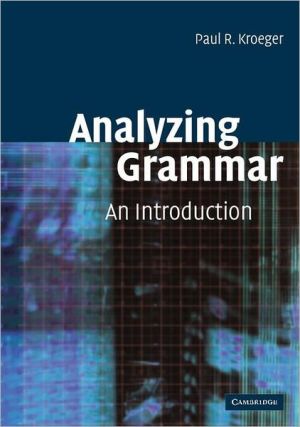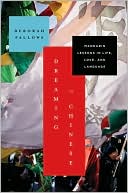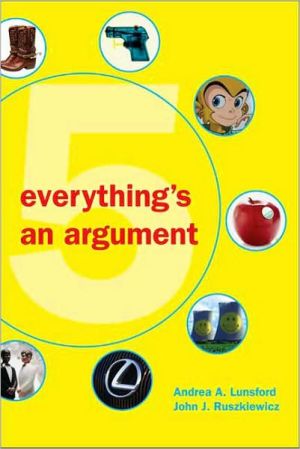Analyzing Grammar
Covering both syntax (the structure of phrases and sentences) and morphology (the structure of words), this book equips students with the tools and methods needed to analyze grammatical patterns in any language. Students are shown how to use standard notational devices such as phrase structure trees and word-formation rules, as well as prose descriptions. Emphasis is placed on comparing the different grammatical systems of the world's languages, and students are encouraged to practice the...
Search in google:
Analyzing Grammar is a clear introductory textbook on grammatical analysis, showing students how to analyse grammatical patterns in any language.
\ Cambridge University Press\ 0521816229 - Analyzing Grammar - An Introduction - by Paul R. Kroeger\ Excerpt\ \ \ \ \ 1 Grammatical form\ \ \ \ 1.1 Form, meaning, and use\ Why do people talk? What is language for? One common answer to this question is that language is a complex form of communication, and that people talk in order to share or request information. That is certainly a very important use of language, but clearly it is not the only use.\ For example, what is the meaning of the word hello? What information does it convey? It is a very difficult word to define, but every speaker of English knows how to use it: for greeting an acquaintance, answering the telephone, etc. We might say that hello conveys the information that the speaker wishes to acknowledge the presence of, or initiate a conversation with, the hearer. But it would be very strange to answer the phone or greet your best friend by saying "I wish to acknowledge your presence" or "I wish to initiate a conversation with you." What is important about the word hello is not its information content (if any) but its use in social interaction.\ In the Teochew language (a "dialect" of Chinese), there is no word for 'hello'. The normal way for one friend to greet another is to ask: "Have you already eaten or not?" The expected reply is: "I have eaten," even if this is not in fact true.\ Now no one would want to say that hello means "Have you eaten yet?" But, in certain contexts, the English word and the Teochew question may be used for the same purpose or function, i.e. as a greeting. This example illustrates why it is helpful to distinguish between the meaning (or SEMANTIC content) of an utterance and its function (or PRAGMATIC content).\ Of course, in many contexts there is a close relationship between meaning and function. For example, if a doctor wants to administer a certain medicine which cannot be taken on an empty stomach, he will probably ask the patient: "Have you eaten?" In this situation both the meaning and the function of the question will be essentially the same whether the doctor is speaking English or Teochew. The FORM, however, would be quite different. Compare the Teochew form in (1a) with its English translation in (1b):\ \ \ (1)\ a\ Lɨ\ chyaʔ\ pa\ boy?\ \ \ \ \ you\ eat\ full\ not.yet\ \ \ \ b\ Have you already eaten?\ \ \ Obviously the words themselves are different, but there are grammatical differences as well. Both sentences have the form of a question. In Teochew this is indicated by the presence of a negative element ('not yet') at the end of the sentence, while in English it is indicated by the special position of the auxiliary verb have at the beginning of the sentence.\ This book is primarily concerned with describing linguistic FORM, and in particular with describing grammatical structure. (What we mean by "grammatical structure" will be discussed below.) But in our study of these structural features, we will often want to talk about the meaning of a particular form and/or how it is used. The Teochew example illustrates how a particular form may be used for different functions, depending on the context. This means that the form of an utterance by itself (ignoring context) does not determine its function. But it is equally true that function by itself does not fully determine the form. In other words, we cannot fully explain the form of an utterance while ignoring meaning and function; at the same time, we cannot account for the form of an utterance by looking only at its meaning and function.\ \ 1.2 Aspects of linguistic form\ In describing the grammar of a language, we are essentially trying to explain why speakers recognize certain forms as being "correct" but reject others as being "incorrect." Notice that we are speaking of the acceptability of the form itself, rather than the meaning or function which it expresses. We can often understand a sentence perfectly well even if it is not grammatically correct, as illustrated in (2).\ \ \ (2)\ a\ Me Tarzan, you Jane.\ \ \ \ b\ Those guys was trying to kill me.\ \ \ \ c\ When he came here?\ \ \ Conversely, the form of a sentence may be accepted as correct even when the meaning is obscure or absurd. An extreme example of this is found in Lewis Carroll's famous poem Jabberwocky, from the book Through the Looking Glass. The poem begins as follows:\ Jabberwocky\ 'Twas brillig, and the slithy toves\ Did gyre and gimble in the wabe;\ All mimsy were the borogoves,\ And the mome raths outgrabe.\ "Beware the Jabberwock, my son!\ The jaws that bite, the claws that catch!\ Beware the Jubjub bird, and shun\ The frumious Bandersnatch!"\ (Another five verses follow in a similar style.) After reading this poem, a native speaker of English will very likely feel as Alice did (pp. 134- 136):\ "It seems very pretty," she said when she had finished it, "but it's rather hard to understand!" (You see she didn't like to confess even to herself, that she couldn't make it out at all.) "Somehow it seems to fill my head with ideas - only I don't exactly know what they are!"\ In the second verse, we can at least guess that the Jabberwock is some kind of beast, the Jubjub is a kind of bird, and the Bandersnatch is something dangerous and probably animate. But the first verse is almost total nonsense; the "function" words (i.e. conjunctions, articles, prepositions, etc.) are real English words, but almost all the content words (nouns, verbs, etc.) are meaningless.\ As noted in section 1.1, language is normally used to communicate some MEANING from the speaker to the hearer. In these verses very little meaning is communicated, yet any speaker of English will recognize the poem as being English. How is this possible? Because the FORM of the poem is perfectly correct, and in fact (as Alice points out) quite pretty. Thus in one sense the poem is successful, even though it fails to communicate.\ Let us look at some of the formal properties of the poem which make it recognizable, although not comprehensible, as English. First, of course, the whole poem "sounds" like English. All of the nonsense words are pronounced using sounds which are phonemes in English. These sounds are represented in written form using English spelling conventions. And these phonemes are arranged in permissible sequences, so that each nonsense word has the phonological shape of a possible word in English. For example, brillig and gimble could be English words; in a sense it is just an accident that they do not actually mean anything. In contrast, bgillir and gmible are not possible English words, because they violate the rules for combining sounds in English.\ In addition, Carroll has skillfully made many of the nonsense words resemble real words which could occur in the same position: brillig reminds us of brilliant and bright; slithy reminds us of slippery, slimy, slithering, etc.\ Second, the sentence patterns are recognizably those of English, specifically of a poetic and slightly old-fashioned style of English. We have noted that most of the function words (the, and, in, were, etc.) are real English words, and they occur in their proper place in the sentence. Similarly real content words like son, shun, jaws, claws, etc. are used in appropriate positions. We can generally identify the PART OF SPEECH (or CATEGORY) of each of the nonsense words by the position in which we find it. For example, slithy, frumious, and (probably) mome must be adjectives, while gyre and gimble (and probably outgrabe) are verbs. (In chapter 3, section we will discuss some of the specific clues which allow us to reach these conclusions.)\ Besides the word order, there are other clues about word categories. For example, we can see that toves, borogoves, and raths are nouns, not only because they all follow the definite article the (and perhaps an adjective) but also because they all contain a final -s which is used in English to indicate PLURALITY (more than one). This marker can only be attached to nouns. Similarly, the final -ous in frumious is typically found only in adjectives, which reinforces our earlier conclusion that frumious must be an adjective. And in the following couplet (from a later verse):\ "And hast thou slain the Jabberwock?\ Come to my arms, my beamish boy!"\ the word beamish contains an ending -ish which is found in many adjectives; this confirms what we could already guess based on position.\ Finally, the form of the poem as a whole conforms to a number of important conventions. The poem is divided into stanzas containing exactly four lines each. The first stanza, which seems to provide a kind of setting, is repeated verbatim at the end of the poem to create a frame around the story. The last word in each line, whether it means anything or not, fits into the A-B-A-B rhyme pattern typical of much English poetry. Each line has exactly four stressed syllables, with stressed and unstressed syllables alternating in a fixed rhythmic pattern. These features serve to identify this extended utterance as a coherent text, or DISCOURSE, of a certain type.\ So there are at least four kinds of formal properties that Carroll manipulates to make his poem effective: sound patterns, word shapes, sentence patterns, and discourse structure. In this book we will be very much concerned with sentence patterns (SYNTAX) and word shapes (MORPHOLOGY), but only indirectly concerned with sound patterns (PHONOLOGY). And, due to limitations of space, we will not be able to deal with discourse structure here.\ \ 1.3 Grammar as a system of rules\ One way to evaluate a person's progress in learning a new language is to measure their vocabulary: how many words do they know? But it does not make sense to ask, "How many sentences does this person know?" Vocabulary items (words, idioms, etc.) are typically learned one at a time, but we do not "learn" sentences that way. Rather than memorizing a large inventory of sentences, speakers create sentences as needed. They are able to do this because they "know" the rules of the language. By using these rules, even a person who knew only a limited number of words could potentially produce an extremely large number of sentences.\ Now when we say that a speaker of English (or Tamil, or Chinese) "knows" the rules for forming sentences in that language, we do not mean that the person is aware of this knowledge. We need to distinguish between two different kinds of rules. There are some rules about using language that must be consciously learned, the kind of rules we often learn in school. Rules of this kind are called PRESCRIPTIVE rules: rules which define a standard form of the language, and which some authority must explicitly state for the benefit of other speakers.\ The rules we are interested in here are those which the native speaker is usually not aware of - the kind of knowledge about the language that children learn naturally and unconsciously from their parents and other members of their speech community, whether they attend school or not. All languages, whether standardized or not, have rules of this kind, and these rules constitute the grammar of the language. Our approach to the study of grammar will be DESCRIPTIVE rather than prescriptive: our primary goal will be to observe, describe, and analyze what speakers of a language actually say, rather than trying to tell them what they should or should not say.\ We have seen that there are rules in English concerning the sequence of sounds within a word. Similarly there are rules for the arrangement of words within a sentence, the arrangement of "meaningful elements" within a word, etc. The term GRAMMAR is often used to refer to the complete set of rules needed to produce all the regular patterns in a given language. Another, perhaps older, way in which the term GRAMMAR is sometimes used means roughly "all the structural properties of the language except sound structure (phonology)," i.e. the structure of words, phrases, sentences, texts, etc. This book is concerned with grammar in both senses. It is intended to help prepare you to analyze and describe the word and sentence patterns of a language (sense 2) by formulating a set of rules (sense 1) which account for those patterns.\ \ 1.4 Conclusion\ Even though there is a close relationship between linguistic form and meaning, there is also a certain amount of independence between them. Neither can be defined in terms of the other: speakers can produce both grammatical sentences which are meaningless, and meaningful sentences which are ungrammatical.\ In our comparison of English with Teochew, we saw that both languages employ a special form of sentence for expressing Yes-No questions. In fact, most, if not all, languages have a special sentence pattern which is used for asking such questions. This shows that the linguistic form of an utterance is often closely related to its meaning and its function. On the other hand, we noted that the grammatical features of a Yes-No question in English are not the same as in Teochew. Different languages may use very different grammatical devices to express the same basic concept. So understanding the meaning and function of an utterance will not tell us everything we need to know about its form.\ Many aspects of linguistic form are arbitrary conventions shared by the speakers of a given language. For example, in English (and in most other European languages) the subject of a sentence normally occurs before the verb; but in most Philippine languages the subject normally occurs after the verb. This difference might be called arbitrary, in that it does not reflect a contrast in meaning or function. But this does not mean that the difference is random. Word-order facts within any given language tend to show interesting patterns of correlation, and the patterns observed in different languages tend to vary in limited and systematic ways.\ One of our primary goals as linguists is to discover the patterns of regularity that exist in the grammatical systems of individual languages, as well as the recurring patterns common to many languages. This book introduces some basic concepts and techniques that can help you in these tasks. Our study of grammatical structure will frequently involve a discussion of meaning (semantic content), and to a lesser extent of function as well. However, it has not been possible within the limitations of this volume to address either semantics or pragmatics in any systematic way. It is hoped that readers of this book will go on to study other books where those issues are discussed in greater detail.\ \ \ \ \ \ \ 2 Analyzing word structure\ \ \ \ An important design feature of human language is the fact that larger units are composed of smaller units, and that the arrangement of these smaller units is significant. For example, a sentence is not just a long series of speech sounds; it is composed of words and phrases, which must be arranged in a certain way in order to achieve the speaker's goals. Similarly, words (in many languages) may be composed of smaller units, each of which has its own meaning, and which must be arranged in a particular way.\ In order to analyze the structure of a word or sentence, we need to identify the smaller parts from which it is formed and the patterns that determine how these parts should be arranged. This chapter introduces some basic aspects of word structure (morphology), and some techniques for analyzing it. More complicated aspects of morphological structure will be discussed in chapters 13- 17.\ Section 2.1 deals with the problem of identifying the component parts of a word. The association between form and meaning, which we discussed in chapter 1, plays a critical role in this process. Some of the basic techniques we will need are also useful for analyzing sentences, and we will first introduce them in that context. Section 2.2 discusses the kinds of parts which can be combined to form words, sections 2.3-2.4 provide a method for displaying the arrangement of these parts, and section 2.5 gives a brief overview of the different types of word structure found in the world's languages.\ \ 2.1 Identifying meaningful elements\ 2.1.1 Identifying word meanings\ Consider the following sentence in the Lotuko language of Sudan:\ \ \ (1)\ a\ idulak atulo ema\ 'The man is planting grain.'\ \ \ Although we know the meaning of the sentence as a whole, we cannot be sure what any of the individual words mean. One sentence in isolation tells us almost nothing; we need to compare it with something:\ \ \ (2)\ a\ idulak atulo ema\ 'The man is planting grain.'\ \ \ \ b\ idulak atulo aful\ 'The man is planting peanuts.'\ \ \ These two Lotuko sentences constitute a MINIMAL PAIR, because they are identical except for a single element (in this case the final words, ema vs. aful). The beginning of the sentence (idulak atulo . . .) provides a context in which the words ema and aful stand in CONTRAST to each other. Two linguistic elements are said to be in CONTRAST when (ⅰ) they can occur in the same environment(s), and (ⅱ) replacing one with the other creates a difference in meaning.1\ The examples in (2) allow us to form a HYPOTHESIS that the word ema means 'grain' and aful means 'peanuts.' It seems quite likely that this hypothesis will turn out to be correct, because it is based on a type of evidence (a minimal pair, or CONTRAST IN IDENTICAL ENVIRONMENTS) which is usually quite reliable. However, any hypothesis based on just two examples is only a first guess - it must be checked against more data. What information do the sentences in (3) provide?\ \ \ (3)\ c\ ohonya eito erizo\ 'The child is eating meat.'\ \ \ \ d\ amata eito aari\ 'The child is drinking water.'\ \ \ Both of these sentences contain the word eito, and the English translation for both sentences contains the phrase the child. This observation suggests the hypothesis that the word eito means 'the child.' In this case our hypothesis is based on the assumption that there is a regular association between the recurring Lotuko word (eito) and the recurring element of meaning ('the child'). This process of identifying recurring elements of form which correlate with recurring elements of meaning is sometimes referred to as the method of RECURRING PARTIALS WITH CONSTANT MEANING (Elson and Pickett 1988:3).\ Both of the hypotheses we have reached so far about Lotuko words are based on the assumption that the meaning of a sentence is composed in some regular way from the meanings of the individual words. That is, we have been assuming that sentence meanings are COMPOSITIONAL. Of course, every language includes numerous expressions where this is not the case. Idioms are one common example. The English phrase kick the bucket can mean 'die,' even though none of the individual words has this meaning. Nevertheless, the compositionality of meaning is an important aspect of the structure of all human languages.\ Based on the four Lotuko sentences we have examined so far, which are repeated in (4), can we determine the meaning of any additional words?\ \ \ (4)\ a\ idulak atulo ema\ 'The man is planting grain.'\ \ \ \ b\ idulak atulo aful\ 'The man is planting peanuts.'\ \ \ \ c\ ohonya eito erizo\ 'The child is eating meat.'\ \ \ \ d\ amata eito aari\ 'The child is drinking water.'\ \ \ We can at least make some guesses, if we assume that the word order is the same in each sentence. The minimal pair in (2) allowed us to identify the words expressing the direct object, and those words occurred at the end of the sentence. The repeated word in (3) expressed the subject, and it occurred in the middle. Assuming that all four sentences have the same word order, then the verb must come first and the order of elements must be Verb-Subject-Object (VSO). Based on this hypothesis, try to identify the unknown words in (4).\ This kind of reasoning depends on another important feature of linguistic structure, namely that the arrangement of linguistic units often follows a systematic pattern of some kind. We arrived at a hypothesis about the structure of a simple sentence, and used that hypothesis to make some guesses about word meanings. But be careful - a hypothesis based on this kind of reasoning needs to be checked carefully. Many languages do not require consistent word order within a sentence, and most languages allow for some variation in word order. So we need to look for additional data to test our hypotheses. What evidence does the sentence in (5) provide as to the correctness of your guesses in (4)?\ \ \ 5\ e\ ohonya odwoti aful\ 'The girl is eating peanuts.'\ \ \ Now use the methods discussed above to find the meanings of any unknown words in (6), confirm or disprove the specific hypotheses stated above, and fill in the blanks for sentences h and i:\ \ \ (6)\ Lotuko (Sudan; adapted from Merrifield et al. 1987, prob. 131)\ \ \ \ a\ idulak atulo ema\ 'The man is planting grain.'\ \ \ \ b\ idulak atulo aful\ 'The man is planting peanuts.'\ \ \ \ c\ ohonya eito erizo\ 'The child is eating meat.'\ \ \ \ d\ amata eito aari\ 'The child is drinking water.'\ \ \ \ e\ ohonya odwoti aful\ 'The girl is eating peanuts.'\ \ \ \ f\ abak atulo ezok\ 'The man hit the dog.'\ \ \ \ g\ amata odwoti aari\ 'The girl is drinking water.'\ \ \ \ h\ ________________\ 'The girl hit the child.'\ \ \ \ i\ ohonya ezok erizo\ ___________________\ \ \ Let us review what we have learned so far. We have identified three types of evidence that can be used to form hypotheses about the meanings of words: minimal contrast, recurring partials, and pattern-matching. These methods cannot be applied to a single example in isolation, but involve comparing two or more examples. The methods work best if the examples are reasonably similar to each other. In this data set, all the sentences contain the same three elements in the same order (verb, subject, object), and the same specific words are used over and over. So selecting the right data and organizing them in the right way are crucial steps in analyzing the grammatical patterns of a language.\ The methods of recurring partials and minimal contrast simply allow us to identify new words. The recognition of structural patterns in the data (e.g. the VSO word order) not only helps us to identify new forms but also allows us to use the language creatively, that is, to produce or understand sentences we have never heard before (as in [6h, i]). In those examples, our hypothesis about the rule of sentence formation enabled us to make predictions that could be tested by consulting native speakers of Lotuko. It is important that our analysis of the grammar be stated in a way that allows us to make clear and testable predictions. Otherwise there is no way to be sure whether our claims about the language are correct or not.\ \ 2.1.2 Identifying meaningful elements within words\ The kinds of reasoning discussed in the previous section can be used to identify parts of words as well. Consider, for example, the following data from the Isthmus Zapotec language of Mexico (Merrifield et al. 1987, prob. 9):\ \ \ (7)\ kañee\ 'feet'\ kaʒigi\ 'chins'\ \ \ \ ñeebe\ 'his foot'\ ʒigibe\ 'his chin'\ \ \ \ kañeebe\ 'his feet'\ \ \ \ \ \ ñeeluʔ\ 'your foot'\ ʒigiluʔ\ 'your chin'\ \ \ \ kañeetu\ 'your (pl) feet'\ kaʒigitu\ 'your (pl) chins'\ \ \ \ kañeedu\ 'our feet'\ kaʒigidu\ 'our chins'\ \ \ All of the words which contain the string /ñee/ have GLOSSES (translations) which involve the idea 'foot,' and all of the words which contain the string /ʒigi/ have glosses which contain the English word 'chin.' So the method of recurring partials allows us to identify the form ñee as meaning 'foot' and the form ʒigi as meaning 'chin.' Further data show that these forms, ñee and ʒigi, can occur as independent words in their own right.\ We also notice that whenever the word begins with the sequence ka-, the English translation equivalent uses a plural form of the noun; so (again by the method of recurring partials) we might guess that ka- is a marker of plurality. This hypothesis can be confirmed by finding minimal pairs in (8). Why doesn't example (7) contain a form meaning 'his chins?' How would you say it if you needed to?\ \ \ (8)\ ñee\ 'foot'\ ñeebe\ 'his foot'\ ʒigi\ 'chin'\ \ \ \ kañee\ 'feet'\ kañeebe\ 'his feet'\ kaʒigi\ 'chins'\ \ \ We can also use minimal contrasts to identify elements corresponding to the possessive pronouns in the English gloss. The forms -be 'his', -tu 'your (plural)', and -du 'our' occur in identical environments, as shown in (9), providing a minimally contrastive set.\ \ \ (9)\ kañeebe\ 'his feet'\ \ \ \ kañeetu\ 'your (pl) feet'\ \ \ \ kañeedu\ 'our feet'\ \ \ \ \ \ \ \ © Cambridge University Press
1Grammatical form12Analyzing word structure73Constituent structure264Semantic roles and grammatical relations515Lexical entries and well-formed clauses666Noun phrases877Case and agreement1028Noun classes and pronouns1289Tense, aspect, and modality14710Non-verbal predicates17311Special sentence types19612Subordinate clauses21813Derivational morphology24714Valence-changing morphology27015Allomorphy28816Non-linear morphology30417Clitics316AppSwahili data for grammar sketch334








